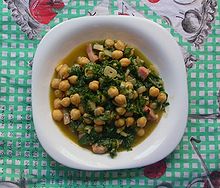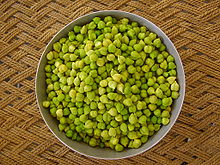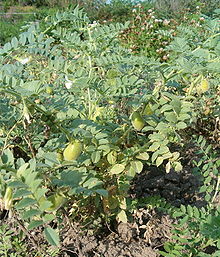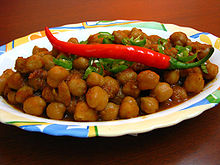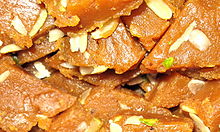- Chickpea
-
Chickpea 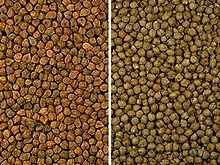
Left: Bengal (Indian) variety; right: European variety Scientific classification Kingdom: Plantae (unranked): Angiosperms (unranked): Eudicots (unranked): Rosids Order: Fabales Family: Fabaceae Genus: Cicer Species: C. arietinum Binomial name Cicer arietinum
L.The chickpea (Cicer arietinum) (also ceci bean, garbanzo bean, chana, sanagalu Indian pea, Bengal gram) is a legume of the family Fabaceae, subfamily Faboideae. Its seeds are high in protein and it is one of the earliest cultivated vegetables; 7,500-year-old remains have been found in the Middle East.[1]
Contents
Etymology
The name "chickpea" traces back through the French chiche to cicer, Latin for ‘chickpea’ (from which the Roman cognomen Cicero was taken). The Oxford English Dictionary lists a 1548 citation that reads, "Cicer may be named in English Cich, or ciche pease, after the Frenche tonge." The dictionary cites "Chick-pea" in the mid-18th century; the original word in English taken directly from French was chich, found in print in English in 1388 and became obsolete in the 18th century.
The word garbanzo came to English as "calavance" in the 17th century, from Old Spanish (perhaps influenced by Old Spanish garroba or algarroba), though it came to refer to a variety of other beans (cf. Calavance). The Portuguese (?) arvanço has suggested to some that the origin of the word garbanzo is in the Greek erebinthos.[2] But the Oxford English Dictionary notes that some scholars doubt this; it also mentions a possible origination in the word garbantzu, from Basque — a non-Indo-European tongue — in which it is a compound of garau, seed + antzu, dry.
History
Domesticated chickpeas have been found in the aceramic levels of Jericho (PPNB) along with Cayönü in Turkey and in Neolithic pottery at Hacilar, Turkey. They are found in the late Neolithic (about 3500 BCE) at Thessaly, Kastanas, Lerna and Dimini. In southern France Mesolithic layers in a cave at L'Abeurador, Aude have yielded wild chickpeas carbon dated to 6790±90 BCE.[3]
By the Bronze Age, chickpeas were known in Italy and Greece. In classical Greece, they were called erébinthos and eaten as a staple, a dessert, or consumed raw when young. The Romans knew several varieties such as venus, ram, and punic chickpeas. They were both cooked down into a broth and roasted as a snack. The Roman gourmet Apicius gives several recipes for chickpeas. Carbonized chickpeas have been found at the Roman legion fort at Neuss (Novaesium), Germany in layers from the first century CE, along with rice.
Chickpeas are mentioned in Charlemagne's Capitulare de villis (about 800 CE) as cicer italicum, as grown in each imperial demesne. Albertus Magnus mentions red, white and black varieties. Nicholas Culpeper noted "chick-pease or cicers" are less "windy" than peas and more nourishing. Ancient people also associated chickpeas with Venus because they were said to offer medical uses such as increasing sperm and milk, provoking menstruation and urine and helping to treat kidney stones.[citation needed] Wild cicers were thought to be especially strong and helpful.[citation needed]
In 1793, ground-roast chickpeas were noted by a German writer as a coffee substitute in Europe. In the First World War, they were grown for this use in some areas of Germany. They are still sometimes brewed instead of coffee.[4][5]
Description
The plant grows to between 20–50 cm (8–20 inches) high and has small feathery leaves on either side of the stem. Chickpeas are a type of pulse, with one seedpod containing two or three peas. It has white flowers with blue, violet or pink veins. Chickpeas need a subtropical or tropical climate with more than 400 millimetres (16 in) of annual rain.[citation needed] They can be grown in a temperate climate but yields will be much lower.[citation needed]
Types
There are two main kinds of chickpea:
- Desi, which has small, darker seeds and a rough coat, cultivated mostly in the Indian subcontinent, Ethiopia, Mexico, and Iran.
- Kabuli, which has lighter coloured, larger seeds and a smoother coat, mainly grown in Southern Europe, Northern Africa, Afghanistan, Pakistan and Chile, also introduced during the 18th century to the Indian subcontinent.[6]
The Desi (meaning 'country' or 'local' in Hindi) is also known as Bengal gram or kala chana. Kabuli (meaning 'from Kabul' in Hindi, since they were thought to have come from Afghanistan when first seen in India) or safed chana is the kind widely grown throughout the Mediterranean. Desi is likely the earliest form since it closely resembles seeds found both on archaeological sites and the wild plant ancestor of domesticated chickpeas (Cicer reticulatum) which only grows in southeast Turkey, where it is believed to have originated. Desi chickpeas have a markedly higher fiber content than Kabulis and hence a very low glycemic index which may make them suitable for people with blood sugar problems.[7] The desi type is used to make Chana Dal, which is a split chickpea with the skin removed.
Cultivation and use
Chickpeas are grown in the Mediterranean, western Asia, the Indian subcontinent and Australia.
Mature chickpeas can be cooked and eaten cold in salads, cooked in stews, ground into a flour called gram flour (also known as chickpea flour and besan and used primarily in Indian cuisine), ground and shaped in balls and fried as falafel, fermented to make an alcoholic drink similar to sake,[citation needed] stirred into a batter and baked to make farinata, cooked and ground into a paste called hummus or roasted, spiced and eaten as a snack (such as leblebi). Some varieties of chickpeas can even be popped and eaten like popcorn.[8] Chick peas and Bengal grams are used to make curries and are one of the most popular vegetarian foods in India, Pakistan, Bangladesh and the UK. On the Indian subcontinent, green chickpeas are called Chana (ચણા) in Gujarati Harbharaa in Marathi, while other varieties are known as Kadale Kaalu in Kannada, Shanaga (శనగ) in Telugu, chana in Hindi and other Indic languages, small brown peas are called Chhola and the whitish bigger variety is called Kabuli Chhola in Bengali and Konda Kadalai in Tamil,[9] where they are a major source of protein in a mostly vegetarian culture. Typically Chana in Hindi and Punjabi might refer to both varieties, as might chhole, but the former is more the green hard small variety while the latter is the large creamy softer one and also the more popular dish served around the region at home and at celebrations.
Many popular dishes in Indian cuisine are made with chickpea flour, such as Mirchi Bajji and Mirapakaya bajji Telugu. In India, as well as in the Levant, unripe chickpeas are often picked out of the pod and eaten as a raw snack and the leaves are eaten as a green vegetable in salads. Chickpea flour is also used to make "Burmese Tofu" which was first known among the Shan people of Burma. The flour is used as a batter to coat various vegetables and meats before frying, such as with panelle, a chickpea fritter from Sicily.[10] Chickpea flour is also used to make the mediterranean flatbread socca.
In the Philippines, garbanzo beans preserved in syrup are eaten as sweets and in desserts such as halo-halo. Ashkenazi Jews traditionally serve whole chickpeas at a Shalom Zachar celebration for baby boys.[11]
Dried chickpeas need a long cooking time (1–2 hours) but will easily fall apart when cooked longer. If soaked for 12–24 hours before use, cooking time can be shortened by around 30 minutes.
Chickpeas (Cicer arietinum) do not cause lathyrism. Similarly named "chickling peas" (Lathyrus sativus) and other plants of the genus Lathyrus contain the toxins associated with lathyrism.
Production
India is the world leader in chickpea (Bengal gram) production followed by Pakistan and Turkey.
Top ten chick peas producers — 11 June 2008 Country Production (Tonnes) Footnote  India
India5,970,000  Pakistan
Pakistan842,000  Turkey
Turkey523,000  Australia
Australia313,000  Iran
Iran310,000 F  Myanmar
Myanmar225,000 F  Canada
Canada215,000  Ethiopia
Ethiopia190,000 F  Mexico
Mexico165,000 F  Iraq
Iraq85,000 F World 9,000,000 A No symbol = official figure, F = FAO estimate, * = Unofficial/Semi-official/mirror data,
C = Calculated figure, A = Aggregate (may include official, semi-official or estimates);
Source: Food And Agricultural Organization of United Nations: Economic And Social Department: The Statistical Division, faostat.fao.org
Nutrition
Chickpeas, mature seeds, cooked no salt Nutritional value per 100 g (3.5 oz) Energy 686 kJ (164 kcal) Carbohydrates 27.42 g - Sugars 4.8 g - Dietary fiber 7.6 g Fat 2.59 g - saturated 0.269 g - monounsaturated 0.583 g - polyunsaturated 1.156 g Protein 8.86 g Water 60.21 g Vitamin A equiv. 1 μg (0%) Thiamine (vit. B1) 0.116 mg (10%) Riboflavin (vit. B2) 0.063 mg (5%) Niacin (vit. B3) 0.526 mg (4%) Pantothenic acid (B5) 0.286 mg (6%) Vitamin B6 0.139 mg (11%) Folate (vit. B9) 172 μg (43%) Vitamin B12 0 μg (0%) Vitamin C 1.3 mg (2%) Vitamin E 0.35 mg (2%) Vitamin K 4 μg (4%) Calcium 49 mg (5%) Iron 2.89 mg (22%) Magnesium 48 mg (14%) Phosphorus 168 mg (24%) Potassium 291 mg (6%) Sodium 7 mg (0%) Zinc 1.53 mg (16%) Percentages are relative to US recommendations for adults.
Source: USDA Nutrient DatabaseChickpeas are a helpful source of zinc, folate and protein.[12][13] They are also very high in dietary fiber and hence a healthy source of carbohydrates for persons with insulin sensitivity or diabetes.[citation needed] Chickpeas are low in fat and most of this is polyunsaturated. Nutrient profile of desi chana (the smaller variety) is different, especially the fibre content which is much higher than the light coloured variety. One hundred grams of mature boiled chickpeas contains 164 calories, 2.6 grams of fat (of which only 0.27 grams is saturated), 7.6 grams of dietary fiber and 8.9 grams of protein. Chickpeas also provide dietary phosphorus (49–53 mg/100 g), with some sources citing the garbanzo's content as about the same as yogurt and close to milk.[citation needed] According to the International Crops Research Institute for the Semi-Arid Tropics chickpea seeds contain on average:
- 23% protein
- 64% total carbohydrates (47% starch, 6% soluble sugar)
- 5% fat
- 6% crude fiber
- 2% unknown
There is also a high reported mineral content:
- phosphorus (340 mg/100 g)
- magnesium (140 mg/100 g)
- iron (7 mg/100 g)
- zinc (3 mg/100 g)
Recent studies have also shown that they can assist in lowering of cholesterol in the bloodstream.[14][15]
See also
- Extremaduran cuisine
References and notes
- ^ Philologos (October 21, 2005). "Chickpeas — On Language". Jewish Daily Forward. http://www.forward.com/articles/2119/. Retrieved 2009-03-28.
- ^ Garbanzo, dictionary.reference.com, retrieved 31 January 2008
- ^ Zohary, Daniel and Hopf, Maria, Domestication of Plants in the Old World (third edition), Oxford University Press, 2000, p 110
- ^ Chickpea, crnindia.com, retrieved 29 August 2008
- ^ Chickpea, icarda.cgiar.org, retrieved 28 August 2008
- ^ Mansfeld's World Database of Agricultural and Horticultural Crops, Cicer arietinum subsp. arietinum, mansfeld.ipk-gatersleben.de, retrieved 31 January 2008
- ^ Mendosa, David, Chana Dal, mendosa.com, retrieved 31 January 2008
- ^ Deppe, Carol. The Resilient Gardener. Chelsea Green, 2010, p. 241
- ^ Konda Kadalai rendered in Tamil script: கொண்டைக்கடலை
- ^ Foodnetwork.com, Chickpea Fritters: Panelle, retrieved 31 January 2008
- ^ Chickpeas Garbanzo Beans Hummus Falafel, kosherfood.about.com
- ^ Vegsoc.org, "zinc", retrieved 31 January 2008
- ^ Vegsoc.org, "Protein", retrieved 31 January 2008
- ^ Ncbi.nlm.nih.gov
- ^ Mixed Bean Salad (information and recipe) from The Mayo Clinic Healthy Recipes. Accessed February 2010.
External links
- Crop Wild Relatives Gap Analysis Portal reliable information source on where and what to conserve ex-situ, regarding Cicer genepool, gisweb.ciat.cgiar.org
- A traditional way of cooking Chickpea-Chana Masala
- History and nutrition of Chickpeas, Casa Angola Internacional, Portugal (commercial site, in English), cai-sa.pt
- Middle Eastern Chickpea and Tahini Dip, wonderfulingredients.com
- Unripe (or green) chickpea (aka garbanzo, or pois chiches) beans are called guasana, in Mexico and other Latin American countries, which are often eaten raw out of the pod like edamame (unripe soy beans)
- WHfood.org
- Nutritional value, Miniral Content, Various parameters used in trade
- Google n-gram viewer, relative frequency of synonyms for Cicer arietinum in the English language 1770-2000
- Heat and mass transfer during cooking of chickpea (PDF)
Categories:- Faboideae
- Edible legumes
- Medicinal plants
- Puerto Rican ingredients
Wikimedia Foundation. 2010.

